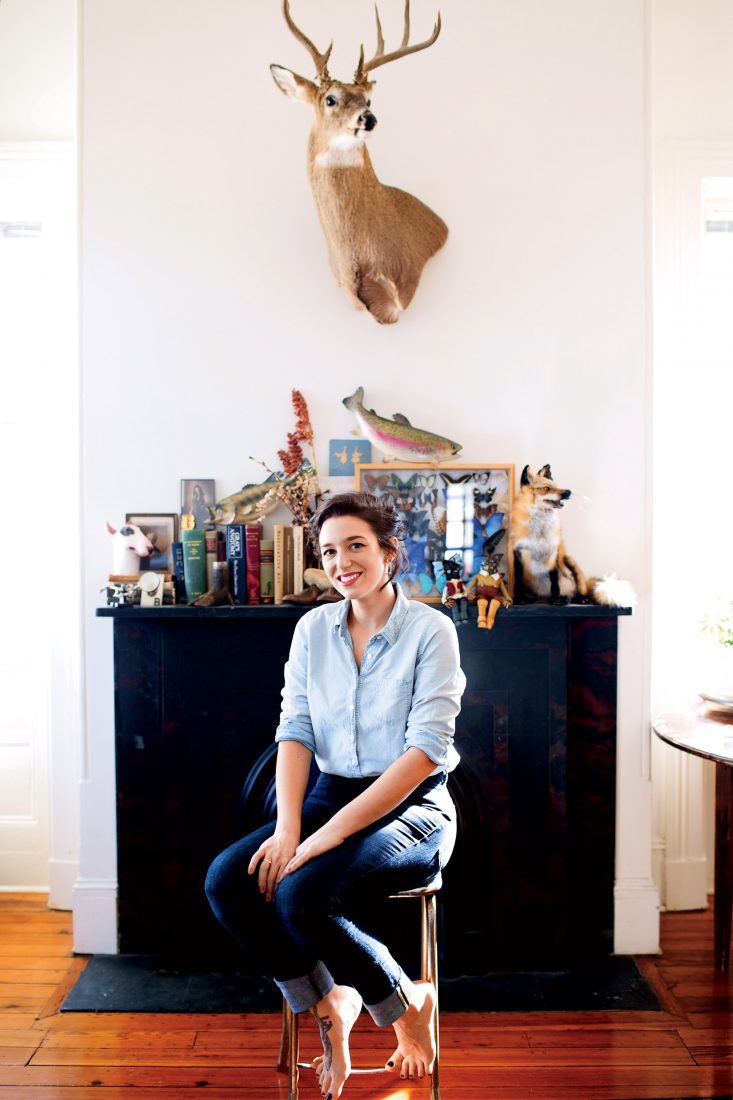In a cozy apartment near Colonial Lake in Charleston, South Carolina, amid a neatly arrayed but still arresting collection of entwined birds’ nests, taut bobcat and deer skins, skulls, and haunting black-and-white vintage photographs of people and their pets (dogs, cats, rabbits), you’ll find a petite and ever-cheery brown-haired young woman named Becca Barnet. You’ll also find her “roommate,” a mild-mannered English bull terrier named Bruce, whom Barnet describes as “a really good business partner.”

Photo: Olivia Rae James
An assortment of mounted skulls.
Barnet, who is twenty-five, is an artist, although her art defies easy description. She’s part taxidermist, part illustrator, part sculptor. Sometimes she combines all three disciplines in a single piece. She is, at heart, a preservationist and refurbisher, of objects and ideas. But the art that comes from that impulse is totally new.
It’s also playful. In one piece, Barnet has staged a family of taxidermy squirrels, all wearing human clothes and living in a dollhouse. Another piece is an illustration of a crow eating a piece of pie (Eat Crow, it’s called). In yet another, five taxidermy plaques are mounted with fabricated teeth in a serious state of decay (enough so that you immediately feel compelled to brush your own). Barnet sculpted the teeth from vintage photos of people suffering from periodontal diseases. “I was playing with what makes things beautiful and what’s acceptable to go up on a wall,” she says. “I like to make people think.”
Her work commands attention, especially her taxidermy and the way she riffs with it, even though she says that when she was growing up in Spartanburg, taxidermy “actually kind of scared me.” She loved animals, though, and had a huge collection of the stuffed toy versions. Barnet went to the Rhode Island School of Design in 2005 to study illustration. “It seemed like the best way to make a career as an artist,” she says. But during her time there, she realized something else intrigued her more, something that lived in the liminal space between the real and the unreal, the quick and the dead. In her senior year, she embarked on an independent study program at the Missouri Taxidermy Institute, living in an RV park and studying for twelve hours a day. “I really fell in love with preservation, the very act of it, the skill set, the patience required, the craft,” she says. “I found that it could be poetic.”

Photo: Olivia Rae James
A rainbow trout and butterfly collection.
Her first job was at the American Museum of Natural History, where she helped build a sixty-foot Mamenchisaurus and created—from scratch—a fabricated platypus nest that looked so true to form that some experts had to pick it up to make sure it wasn’t real. When she moved to Charleston two years later, Barnet started creating art of her own. Her goal, she says, is to reappropriate old objects “to tell a story and give them new life.” Her work has since been exhibited all over Charleston, at the Halsey Institute of Contemporary Art, City Gallery, and at the restaurant the Ordinary.
Her favorite piece? A life-size taxidermy fox. The fact that the fox is not just a traditional taxidermy bust gives it animation, looking like an animal that’s been startled by your presence. “He’s got a lot of spunk and personality,” Barnet says. And for the record, Bruce gets along with it just fine.








